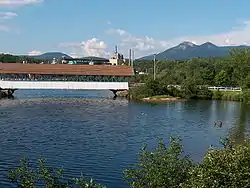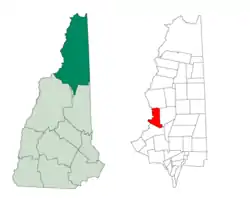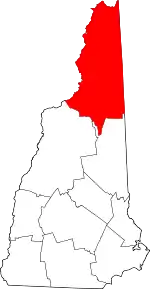Northumberland, New Hampshire
Northumberland is a town located in southwestern Coos County, New Hampshire, U.S., north of Lancaster. It is part of the Berlin, NH–VT micropolitan statistical area. As of the 2010 census, the town population was 2,288,[1] of whom 1,118 lived in the village of Groveton.
Northumberland, New Hampshire | |
|---|---|
Town | |
 Covered bridge over the Upper Ammonoosuc River | |
 Location in Coos County, New Hampshire | |
| Coordinates: 44°33′48″N 71°33′31″W | |
| Country | United States |
| State | New Hampshire |
| County | Coos |
| Incorporated | 1779 |
| Villages | Groveton Northumberland |
| Government | |
| • Board of Selectmen | Christopher Wheelock, Chair James Weagle Michael Phillips |
| Area | |
| • Total | 36.5 sq mi (94.5 km2) |
| • Land | 35.7 sq mi (92.5 km2) |
| • Water | 0.8 sq mi (2.0 km2) 2.13% |
| Elevation | 860 ft (262 m) |
| Population (2010) | |
| • Total | 2,288 |
| • Density | 63/sq mi (24/km2) |
| Time zone | UTC-5 (Eastern) |
| • Summer (DST) | UTC-4 (Eastern) |
| ZIP codes | |
| Area code(s) | 603 |
| FIPS code | 33-56100 |
| GNIS feature ID | 0873688 |
| Website | northumberlandnh |
History
North of the mountain ridge known as Cape Horn, near the Connecticut River, are the remains of Fort Wentworth, built by the New Hampshire Militia in 1755 during the French and Indian War. The town was granted as "Stonington" in 1761 to John Hogg and others by Governor Benning Wentworth, and first settled in 1767 by Thomas Burnside and Daniel Spaulding. It was regranted by Governor John Wentworth in 1771 as "Northumberland", the name derived from Northumberland in England. The town was incorporated November 16, 1779.[2]
Groveton is the northern terminus of a railroad track owned by the New Hampshire & Vermont Railroad, where it intersects the St. Lawrence & Atlantic Railroad. This was formerly the junction of the Grand Trunk Railway and the Boston, Concord & Montreal Railroad—a major point of access for the northern White Mountains.[3]
The area was once known for its large corn and potato crop, starch mills, and manufacturing (leather, shoe pegs). More recently, the town economy centered on the lumber industry. That changed in 2007, however, when the Wausau Paper Mill closed, eliminating 300 jobs.[4]
Geography
According to the United States Census Bureau, the town has a total area of 36.5 square miles (95 km2), of which 35.7 square miles (92 km2) is land and 0.8 square miles (2.1 km2) is water, comprising 2.13% of the town.[5] The Connecticut River, which forms the New Hampshire–Vermont border, runs along the western edge of town. The Upper Ammonoosuc River runs through town in a southwesterly direction to the Connecticut and is crossed by a covered bridge at Groveton.
There are several mountains in town, including Morse Mountain (1,880 ft or 570 m above sea level), Cape Horn (2,040 ft or 620 m), Moore Mountain (1,522 ft or 464 m), and Spaulding Hill (1,220 ft or 370 m). The town's highest point is 2,860 feet (870 m) above sea level on a spur of the Pilot Range on the town's eastern boundary.
Cape Horn State Forest is located in the central portion of the town boundaries.
The nucleus of Northumberland (outside of Groveton) is arranged along US 3, which runs along the Connecticut River. Route 110 intersects US 3 in Northumberland and runs east toward adjacent Stark.
Demographics
| Historical population | |||
|---|---|---|---|
| Census | Pop. | %± | |
| 1790 | 117 | — | |
| 1800 | 205 | 75.2% | |
| 1810 | 281 | 37.1% | |
| 1820 | 205 | −27.0% | |
| 1830 | 342 | 66.8% | |
| 1840 | 399 | 16.7% | |
| 1850 | 429 | 7.5% | |
| 1860 | 736 | 71.6% | |
| 1870 | 955 | 29.8% | |
| 1880 | 1,062 | 11.2% | |
| 1890 | 1,356 | 27.7% | |
| 1900 | 1,977 | 45.8% | |
| 1910 | 2,184 | 10.5% | |
| 1920 | 2,567 | 17.5% | |
| 1930 | 2,360 | −8.1% | |
| 1940 | 2,740 | 16.1% | |
| 1950 | 2,779 | 1.4% | |
| 1960 | 2,586 | −6.9% | |
| 1970 | 2,493 | −3.6% | |
| 1980 | 2,520 | 1.1% | |
| 1990 | 2,492 | −1.1% | |
| 2000 | 2,438 | −2.2% | |
| 2010 | 2,288 | −6.2% | |
| 2017 (est.) | 2,133 | [6] | −6.8% |
| U.S. Decennial Census[7] | |||
As of the census[8] of 2000, there were 2,438 people, 989 households, and 666 families residing in the town. The population density was 67.4 people per square mile (26.0/km2). There were 1,112 housing units at an average density of 30.7 per square mile (11.9/km2). The racial makeup of the town was 98.44% White, 0.25% Native American, 0.33% Asian, and 0.98% from two or more races. Hispanic or Latino of any race were 0.53% of the population.
There were 989 households, out of which 32.3% had children under the age of 18 living with them, 51.3% were married couples living together, 10.1% had a female householder with no husband present, and 32.6% were non-families. 26.7% of all households were made up of individuals, and 13.5% had someone living alone who was 65 years of age or older. The average household size was 2.47 and the average family size was 2.91.
In the town, the population was spread out, with 26.2% under the age of 18, 6.8% from 18 to 24, 27.6% from 25 to 44, 23.5% from 45 to 64, and 15.8% who were 65 years of age or older. The median age was 38 years. For every 100 females, there were 98.5 males. For every 100 females age 18 and over, there were 95.1 males.
The median income for a household in the town was $31,570, and the median income for a family was $34,444. Males had a median income of $33,281 versus $19,464 for females. The per capita income for the town was $15,101. About 9.4% of families and 11.4% of the population were below the poverty line, including 13.4% of those under age 18 and 10.1% of those age 65 or over.
Site of interest
Notable person
- William E. Holyoke, US Navy sailor; recipient of the Medal of Honor
References
- United States Census Bureau, American FactFinder, 2010 Census figures. Retrieved March 23, 2011.
- Coolidge, Austin J.; John B. Mansfield (1859). A History and Description of New England. Boston, Massachusetts: A.J. Coolidge. pp. 605–606.
coolidge mansfield history description new england 1859.
- History of Northumberland, Coos County, New Hampshire Archived 2008-08-21 at the Wayback Machine
- "Groveton paper mill to close, 300 jobs lost". Associated Press. 2007-10-23. Retrieved 2008-05-09.
- "Geographic Identifiers: 2010 Demographic Profile Data (G001) - Northumberland town, New Hampshire". United States Census Bureau. Retrieved November 8, 2011.
- "Annual Estimates of the Resident Population: April 1, 2010 to July 1, 2017 (PEPANNRES): Minor Civil Divisions – New Hampshire". Archived from the original on February 13, 2020. Retrieved November 14, 2018.
- "Census of Population and Housing". Census.gov. Retrieved June 4, 2016.
- "U.S. Census website". United States Census Bureau. Retrieved 2008-01-31.
